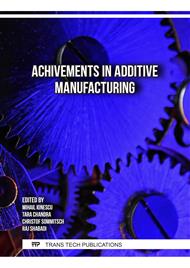p.103
p.109
p.117
p.123
p.129
p.135
p.143
p.151
p.157
High-Throughput Simulations of Phase Precipitation in Additively Manufactured Al Alloy
Abstract:
Additive manufacturing (AM) provides numerous advantages compared to conventional manufacturing methods, such as high design freedom and low material waste. Among the available materials, precipitation-hardenable aluminum alloys are highly attractive for AM due to their high specific strength and low density. Precise control of the processing conditions during AM and post heat treatment (HT) is required to tailor the final mechanical properties. Consequently, many variables, such as the chemical composition and process and HT parameters, must be considered to design suitable alloys for AM. Experimental investigations are, however, limited in variation of these variables. Therefore, computational alloy design approaches allowing for a faster evaluation of many possible variations must be developed. This work presents a high-throughput approach to determine the precipitation kinetics and thermodynamic properties based on the CALculation of PHAse Diagrams (CALPHAD) method. The developed approach is successfully validated for an Al-Mg-Si-Ti-Fe alloy and is applied to screen 243 combinations of chemical compositions and HT parameters. The results confirm the microstructural stability of the Al-Mg-Si-Ti-Fe system to small composition variations.
Info:
Periodical:
Pages:
129-134
Citation:
Online since:
November 2023
Price:
Сopyright:
© 2023 Trans Tech Publications Ltd. All Rights Reserved
Share:
Citation:



